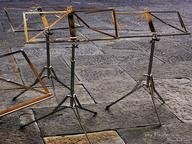Quiz Answer Key and Fun Facts
1. The opera is based on an actual incident during the French Revolution and involves characters who, in many cases, actually existed. However, the central character, Blanche de la Force, is a fictional creation.
2. The opera is based on a novel about the Carmelite martyrs of Compiegne. What was the name of the novel?
3. One of the features of this opera is that Poulenc wanted it always to be sung in the language of whatever country it was being performed in; he was anxious that audiences should understand the text. Where, and in what language, did the opera have its world premiere?
4. As the opera opens, the Marquis de la Force is awaiting the arrival of his daughter Blanche. She is delayed when her carriage is attacked by a mob. This causes the marquis great concern, even after it is ascertained that Blanche is unhurt, because a similar incident had happened to his wife years before. What was the result of this prior incident?
5. What reason does Blanche give for wanting to become a nun?
6. What unusually appropriate name does Blanche select as a novice?
7. Blanche is interviewed at the convent by the elderly, and very ill, prioress Madame de Croissy. The prioress tells Blanche that she had given up a particular comfort many years ago as a penance, but illness has forced her to revert to it. What is she referring to?
8. Blanche meets the childlike Soeur Constance, who takes a liking to her and strikes up an acquaintance. Blanche is startled when Constance tells her of a sudden premonition she has had. What was it?
9. Madame de Croissy is dying and, in accordance with tradition, wants to bid farewell to her daughters. However, she cannot conceal her suffering and her overpowering sense of abandonment and fear. What, in particular, disturbs her about her appearance?
10. Before she dies, Mme de Croissy has a terrifying (and prophetic) vision of the convent chapel abandoned and desecrated and the altar rent asunder. What other grisly detail does she envision?
11. Act II begins with Blanche and Sr Constance keeping vigil over the body of Mme de Croissy, who is lying in state in the chapel. Sr Constance reflects upon the prioress' state at the time of her death; to what does she compare Mme de Croissy's difficult end?
12. The convent must now choose a new prioress to replace Mme de Croissy. Whom do Blanche and Constance hope will be chosen?
13. Mere Marie informs Mme Lidoine that Blanche's brother, the Chevalier de la Force, has come to visit her. Mme Lidoine allows the visit, but makes one unusual request of Mere Marie; what is it?
14. Mme Lidoine is anxious to have the nuns take the vow of martyrdom.
15. Act II ends dramatically with Blanche, who has been given a religious object to hold, is frightened by the noise of the angry mob outside and drops the object on the floor, where it breaks. What is the object?
16. How many of the nuns vote affirmatively to take the vow of martyrdom?
17. Mere Marie finds Blanche at her family home. What is Blanche doing there?
18. How does Mere Marie escape the fate of the other nuns?
19. No one who has ever seen, or even heard this opera will ever forget the shattering effect of the final scene when the nuns, one by one, ascend the scaffold singing the "Salve Regina" as the inhuman thud of the guillotine's blade (heard offstage) cuts short one voice after another until only one is left, then silence. Who are the first and last to ascend the scaffold?
20. Although the nuns sing the "Salve Regina" as they go to the scaffold, the last lines of the opera are from another Latin hymn; which one?
Source: Author
jouen58
This quiz was reviewed by FunTrivia editor
bullymom before going online.
Any errors found in FunTrivia content are routinely corrected through our feedback system.

